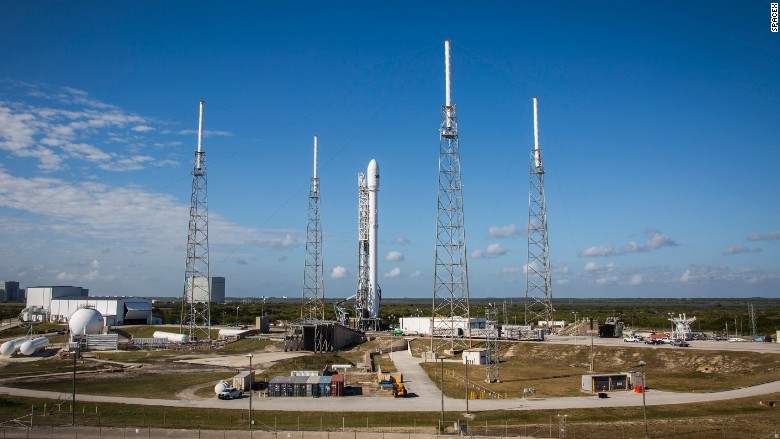
SpaceX delayed launching a new satellite Wednesday that could bring more people online in India, where about 1 billion people don't have internet access.
The private space exploration company headed by Tesla (TSLA) CEO Elon Musk said liftoff is tentatively rescheduled for Thursday at 6:46 pm ET at the Cape Canaveral Air Force Station in Florida.
The launch was put on hold "out of an abundance of caution" due to concerns about the temperature of SpaceX's rocket fuel ingredients, SpaceX said Wednesday evening.
SpaceX also said via Twitter that the "rocket and spacecraft remain healthy."
The company paired up with SES for this mission, and they're sending up a 11,620-pound satellite, called SES-9. SES says the satellite can bolster mobile network coverage and bring high-speed broadband internet access to remote areas in Asian-Pacific countries like India and the Philippines.
Related: NASA gets record number of astronaut applications
It will also allow 22 million homes in the region to get more local and HD channels from their TV providers, and the satellite will be "ideal for providing seamless in-flight connectivity for domestic Asian flights operating in countries like Indonesia and the Philippines."
SES-9 is part of a $1.8 billion investment by SES -- which is traded on the Luxembourg Stock Exchange -- that includes seven new satellites.
The satellite is destined for what's called geostationary orbit -- following a path about 22,400 miles directly above the equator. That will put SES-9 in sync with the Earth's rotation, giving ground-level antennas a fixed target to point toward in order to get the satellite's signal.
Related: Want to clean up India? Turn trash into free Wi-Fi
Jason Davis, who writes about SpaceX for The Planetary Society, explained that geostationary orbit is more than 58 times further than the orbit that SpaceX delivered an Orbcomm (ORBC) satellite payload to in December.
To carry out a successful mission, SpaceX will need extremely powerful rocket fuel, which is made with extremely cold oxygen.
It's not easy, which is why Wednesday's launch was postponed. The SpaceX team was still working to "ensure liquid oxygen temperatures are as cold as possible," the company posted on its website on Wednesday.
SpaceX didn't indicate what the target temperature is for this mission, but Musk said he wanted the liquid oxygen at -340˚F for the December mission.
Liquid oxygen must be kept below -297˚F in order to remain liquid -- and Musk wants to use even colder oxygen because it "increases density and amplifies rocket performance," he tweeted before a December launch.
Davis told CNNMoney that if the oxygen is too warm, the rocket may not have enough thrust to get SES-9 on track to reach geostationary orbit.
Related: $500 Tesla Model S for kids coming in May

SpaceX will also make another attempt to safely land part of its $61.2 million Falcon 9 rocket after Thursday's launch.
The ability to safety land and reuse launch rockets -- which detach from the spacecraft shortly after liftoff -- is key to making space exploration less expensive.
Musk and Amazon CEO Jeff Bezos have both successfully landed a rocket on land, but Musk has been trying to land a rocket on a sea-borne platform. Musk's rocket exploded after one of its landing legs malfunctioned during the last attempt in January.
Missions destined for orbit require the spacecraft to travel at an angle, so those rockets typically wind up over a body of water when they return to Earth.
But SpaceX isn't hopeful that Wednesday will mark their first water-landing success. The company said a mission to geostationary orbit presents additional challenges, and " a successful landing is not expected."

